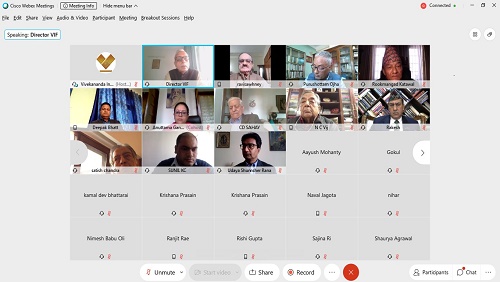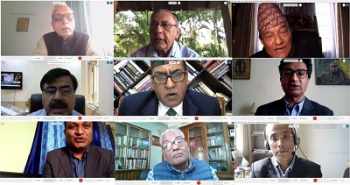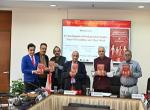On 23rd November 2020 Vivekanand International Foundation India (VIF) and Asian Institute of Diplomacy and International Affairs (AIDIA) organised a round table discussion on India-Nepal Relations. Director Dr Arvind Gupta chaired the session while Gen Ravi Sawhney delivered the welcome comments. Mr. Sunil KC, CEO AIDIA delivered the opening remarks followed with remarks by Amb Ranjit Rae, General Rookmangud Katawal, Lt Gen (Dr) Rakesh Sharma (retd), Mr. Uday SJB Rana, Mr. Sanjay Chadha, Dr. Deepak Prakash Bhatta, Mr. Purshottam Ojha and Dr. Nihar Nayak. From VIF, Gen Ravi Sawhney, Dr Sreeradha Datta, Amb Satish Chanda attended the round table discussion.
This was the second India-Nepal Relationship round table discussion that was being held between the two Institutes. India’s relationship with Nepal is perhaps the most important and unique relationship in the neighbourhood, because of our shared history and also because of the geography of the region.
It was timely held just a few days before the visit of the Indian Foreign Secretary to Nepal. When we talk about India-Nepal relations we always seem to focus on the political cooperation; however, there was a collective consensus that the time has come to focus on economic cooperation and not just on the political one. This economic cooperation has already started, in the form of preparing the detailed project report for the Puncheshwer multipurpose project on the river Mahakali; which when completed has the potential to produce 5600 megawatts of electricity and irrigation potential of 1,30,000 hectors in Nepal and 2,40,000 hectors in India. However, the lack of progress on the Puncheshwer project has created a perception in Nepal that the projects that are taken up by India tend to progress very slowly, the discussion on the Pancheswer project started in the 1990s and still there are issues that need to be sorted for the project to start.
While most speakers believed that in an ideal scenario separating politics from the economics is the way forward but as few opined in the case of India and Nepal that may not be always possible. In fact, many projects that are delayed also due to issues on Nepal’s side including the complex land acquisition regulations.

As Nepal is a landlocked country ninety percent of Nepalese international trade is either with India or it goes through India so it is very important for Nepal that the infrastructure requirements are up to the standard in India so as to not cause problems for Nepalese goods passing through India, but that is not the case. The travel time from the ports of India to Kathmandu is extremely long causing unnecessary delays for Nepal.
India Nepal Treaty of Trade was signed by the two side in the 1960s to control and manage unauthorised movement of goods. In the 1960s when the treaty was signed 95% of Nepal’s trade was with India and even though now the trade with India has gone down Nepal’s trade with India is still at 71%.
The involvement of China in Nepal has increased dramatically in the past fifteen years. This increased involvement of China in Nepal is of grave concern to India and it could be a thorn in India-Nepal relations.
Despite the similarities between the political system, religion, language and culture, the bilateral relationship between the two countries is dominated by distrust and doubts. India is of the opinion that Nepal is willingly siding with many anti India forces that presents a great threat to Indian security concerns. Nepal is of the opinion that India has been a threat to its stability. According to Nepal, India tends to micro manage the internal affairs of Nepal in order to take undue advantage of the situation.
While Nepal has been trying to balance India and China, as Nepal shares its border with both these Asian neighbours yet because of historical ties and the cultural affinities India will always be a strong and reliable partner for Nepal. India and Nepal have a centuries old relationship; both the countries are quite similar to each other in many aspects which influences the bilateral journey. Our commonalities of political, religion and language similarity will continue to enrich our endeavour to deepen this bilateral relationship.







Post new comment